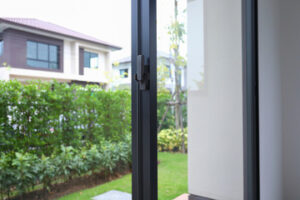Doors play a crucial role in any home, serving as both functional elements and aesthetic features. Over time, they endure significant wear and tear, facing daily use, exposure to weather, and the natural aging of materials. While doors are designed to last for many years, there comes a time when replacement becomes necessary. Recognizing the signs that a door has reached the end of its lifespan is essential for maintaining the safety, efficiency, and appearance of a home. Connect with Door Replacement Cedar Park for reliable help.

One of the most obvious indicators that it might be time for a door replacement is physical damage. Cracks, warping, and dents are often visible signs of wear that not only detract from the appearance of the door but also compromise its structural integrity. A damaged door may no longer close properly, leaving gaps that can let in drafts or even pests. This can lead to discomfort and higher energy costs, as heating or cooling systems must work harder to maintain indoor temperatures. Addressing these issues promptly by replacing the door can restore functionality and enhance the overall efficiency of the home.
Another common sign that a door may need replacing is difficulty in operation. A door that sticks, creaks, or requires excessive force to open or close can be a source of frustration and inconvenience. This issue is often caused by factors such as swelling due to moisture, misaligned frames, or faulty hardware. While minor adjustments or repairs can sometimes resolve the problem, a persistently difficult-to-operate door is often a sign of deeper issues that warrant replacement. A new door ensures smooth operation, improving daily convenience and functionality.
Energy efficiency is another important factor to consider when assessing the condition of a door. Older doors, particularly those made from outdated materials or lacking proper insulation, can significantly impact a home’s energy performance. Gaps, cracks, or inadequate sealing around the door frame allow air to escape, making it harder to maintain a comfortable indoor environment. Modern doors are designed with energy efficiency in mind, featuring advanced materials and construction techniques that minimize heat transfer and reduce energy costs. Replacing an old door with a new, energy-efficient model can lead to long-term savings and a more sustainable home.
Security is another critical aspect to evaluate when determining whether it’s time for a door replacement. A sturdy, well-functioning door is a key element of home security, providing protection against unauthorized entry. Doors that are weak, damaged, or fitted with outdated locks may pose a security risk, leaving the home vulnerable to break-ins. Upgrading to a new door made from durable materials and equipped with modern locking mechanisms enhances safety and peace of mind. Additionally, doors with reinforced cores or integrated security features offer added protection without compromising style.
The appearance of a door also plays a significant role in the overall aesthetic of a home. Over time, exposure to the elements can cause fading, peeling, or discoloration, diminishing the door’s visual appeal. A worn or outdated door may clash with the rest of the home’s design, creating an unbalanced or neglected appearance. Replacing the door provides an opportunity to refresh the look of the home, whether by choosing a contemporary design, a classic style, or a custom option that complements the existing architecture. The right door can elevate the curb appeal of a property, leaving a lasting impression on visitors and potential buyers alike.
In some cases, homeowners choose to replace their doors as part of a larger renovation or upgrade project. Whether adding a new entryway, reconfiguring interior spaces, or updating the overall design of a home, door replacement can be a key element of the transformation. New doors not only enhance functionality but also contribute to the cohesive look and feel of the space. Coordinating door styles and finishes with other design elements ensures a harmonious and polished result that reflects the homeowner’s vision.
The decision to replace a door is not always driven by obvious damage or wear. In some instances, changes in lifestyle or personal preferences may prompt a desire for an upgrade. For example, families with young children or pets may prioritize doors with safety features, such as shatter-resistant glass or built-in blinds. Similarly, individuals seeking greater natural light may opt for doors with larger windows or transparent panels. Modern door designs offer a wide range of customization options, allowing homeowners to tailor their choices to meet specific needs and enhance their quality of life.
When replacing a door, it is important to consider the quality of the materials and craftsmanship. Investing in a high-quality door ensures durability, performance, and longevity, reducing the likelihood of needing future replacements. Materials such as solid wood, fiberglass, or steel offer excellent strength and resistance to wear, while advanced finishes and coatings provide protection against moisture, UV rays, and other environmental factors. Selecting a door from a reputable manufacturer or supplier adds an extra layer of assurance, as these products are often backed by warranties and tested for reliability.
The installation process is another critical aspect of door replacement. Proper installation is essential for ensuring the door functions correctly, provides adequate insulation, and aligns seamlessly with the frame. Working with skilled professionals or experienced contractors can make a significant difference in the outcome, as they have the expertise and tools required to achieve a precise fit. A poorly installed door may lead to issues such as drafts, misalignment, or difficulty in operation, undermining the benefits of the replacement.
Cost is a consideration that often influences the decision to replace a door. While the initial investment may vary depending on the type and design of the door, the long-term benefits often outweigh the expense. Improved energy efficiency, enhanced security, and increased property value are just a few of the advantages that come with a new door. Additionally, modern doors require less maintenance than older models, reducing ongoing costs and effort over time. Homeowners who carefully assess their needs and prioritize quality can make a choice that delivers lasting value and satisfaction.
In conclusion, recognizing when it’s time for door replacement is essential for maintaining the safety, efficiency, and aesthetic appeal of a home. Whether driven by physical damage, operational issues, energy concerns, security needs, or a desire for a fresh look, replacing a door offers numerous benefits that extend beyond its immediate functionality. By carefully evaluating the condition of existing doors, exploring options that align with personal preferences, and investing in quality materials and installation, homeowners can ensure their new doors serve as lasting enhancements to their living spaces.

